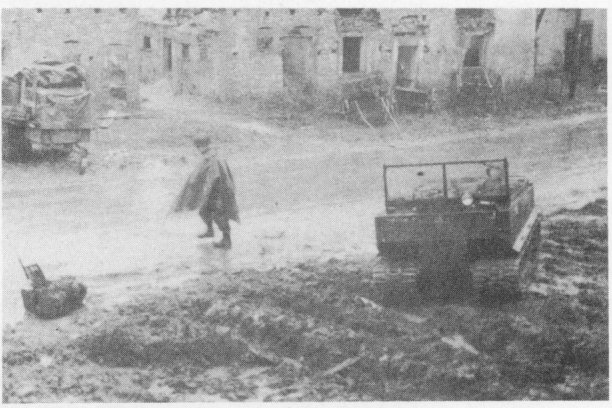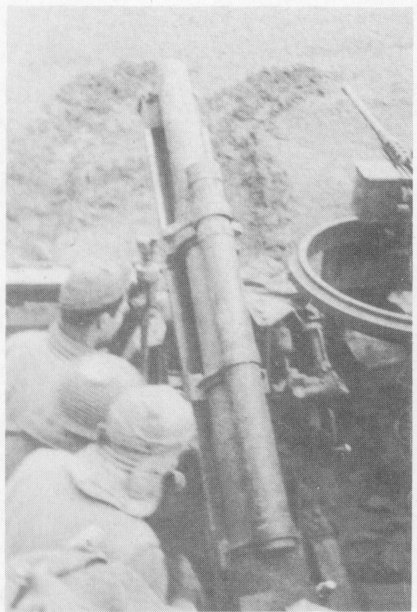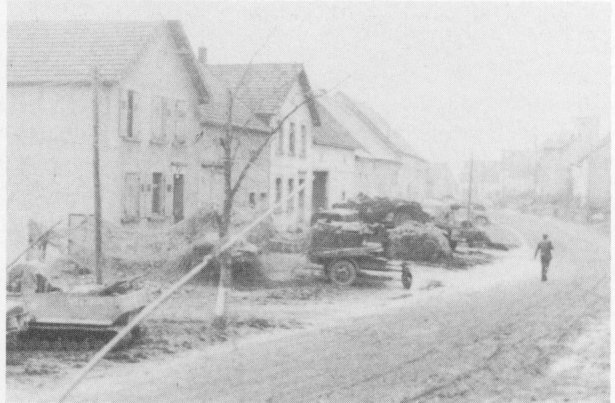 The Moselle Bridgehead |
 Table of Contents |
 Bastogne |
 The Moselle Bridgehead |
 Table of Contents |
 Bastogne |
It rained all night November 7-8 to make the French mud more muddy. But the XII Corps attack jumped off on schedule at 0600 November 8. At 0545 forty artillery battalions began a 40,000-round preparation to pave the way for bridgeheads across the Seille River by the 8Oth and 35th Divisions. Once these were secure, the Fourth Armored Division was to pass through the 35th Division on the right, and the Sixth Armored through the 80th on the left; the objective for both being the German border some fifty miles northeastward. The Fifth Infantry Division was to protect the left flank of the corps as it passed south of Metz and its Maginot defenses.

The 212th, after its 1000-round participation in the giant preparation, displaced a mile and a half to the east, just east of the Foret de Facq, there to support the operations east of the river and to await the commitment of the division. It was again to be part of Combat Command B, and initially in direct support of Task Force Brindel, largely the 86th Reconnaissance Squadron. By November 10, however, when the battalion finally crossed the river, Task Force Lagrew, the 15th Tank Battalion, had replaced the 86th at the head of the Combat Command's left column, and the 212th's mission became direct support of the 15th.
At 0515 November 10, after two busy days supporting the bridgehead, the 212th moved from its Foret de Facq positions to cross the rain-swollen Seille River at Port- sur-Seille. Difficulties with the swift current and high water at the pontoon bridge had caused some unexpected delay, but finally the ball was rolling. The first day the battalion travelled ten miles, reaching Vigny at dusk after a rather hectic march through Eply, Louvigny, and Pagny. Several positions were occupied along the way to fire on enemy rear guard artillery which was continually harassing the whole column. November 11 the march of the combat command continued through Buchy and Beux to the Nied-Francais River, but the 212th withdrew from the march column. Initially it supported the action from its Vigny positions, and at noon displaced to Beux; the day was a busy one for gunners, over 1000 rounds being fired on enemy infantry, vehicles, and more artillery.
On November 12 the attack was to continue across the Nied River at Sanry-Sur-Nied toward Bazoncourt, Chanville, and Arriance, and the battalion was again to move in column behind the 15th Tank Battalion; but direct fire from the Metz forts of Sorbey and Berlize made the crossing at Sanry virtually impassable, and the column's movement was practically nil. The- battalion remained at Beux all day, firing continuously on the two strongly-held forts. The next day advance in the same direction was again attempted, but by mid-afternoon, when Sorbey and Berlize still appeared as strong as ever, the combat command was ordered to cease its operations in this area, move south to the vicinity of Han-sur-Nied, where Combat Command A had seized a Nied River bridge, and there assemble preparatory to continuing the attack eastward on the south side of the division zone; thus far Combat Command B had been advancing on the left. The 212th moved at 1700 south to Luppy, then east through Bechy and Han-sur-Nied to positions at Vatimont.
November 14 while Combat Command B was reorganizing, the battalion was placed in general support of Combat Command A, and at mid-afternoon displaced four miles eastward to positions in and around Brulange. There it was assigned the following day to direct support of Task Force Forrest, the 69th Tank Battalion, for an attack November 16 on Chemery, Adelange, Boustroff, Eincheville, and Viller. The attack was launched at 0900, and the battalion experienced its busiest firing day to date, expending nearly 1800 rounds on strong enemy concentrations of infantry and vehicles, and a number of mortar and artillery positions. Most of the objectives were taken by evening, and reconnaissance for new artillery positions was made, but the battalion did not displace because word was received that the division was to discontinue the attack temporarily and consolidate its present positions. The two remaining days at Brulange were quiet. But the first part of the period had not been; mortar and artillery fire fell in the area regularly till noon the 16th, and on the 15th three men in Battery B were wounded: Sgt. Ralph A. Johnson, Pfc. Alex Valesko, and Pvt. Herman R. Clayborn. The following day Cpl. John K. Snyder, Headquarters Battery, was wounded when the battalion commander's reconnaissance and survey party was subjected to enemy mortar fire.
The division attack was resumed on November 19, with the 212th in general support of Combat Command B, whose objective was Puttelange. At 1015 the battalion displaced eastward six miles to positions around Harprich, but firing all day was comparatively light. The next day direct support of Task Force Forrest was the mission, and a greater number of supporting fires were delivered German infantry and artillery continued to be the main targets. and a few enemy tanks were spotted and fired upon. At noon the battalion moved to positions just outside Bertring.

November 21 was a difficult day for the combat command: strong enemy resistance was encountered from infantry, tanks and anti-tank weapons in the woods east of Gros-Tenquin; and heavy concentrations of enemy artillery and mortars fell on all elements all day long. The battalion delivered over 1400 rounds in support of the day's action, which action took the command to Hellimer. Just before dark Battery A and part of Headquarters Battery displaced to Erstroff in preparation for continued support of the attack the next day. The rest of the battalion followed at 0630 the next morning, and over 1500 rounds were fired during the day from the Erstroff positions.
Thanksgiving Day, November 23, another wet drizzly day, found the battalion displacing at 0745 to positions between Hellimer and Diffembach-les-Hellimer. The attack was to continue that day to St. Jean Rohrbach, the next town on the main road to Puttelange. But a blown culvert over a creek some 1000 yards east of Diffembach delayed the advance until November 25. The delay was typical of the entire November drive: would-be small obstacles and barriers which in good weather would stop nothing, became great problems because the all-enveloping Lorraine mud, made constantly more sticky by the constant rains, rendered armor road-bound and maneuver almost impossible. For the same reason, anti-tank guns were very effective, and the German rear guard used them abundantly. The Thanksgiving intermission was not without its point, however: hot turkey dinner complete with the traditional accoutrements for everyone.
On November 25 the attack for Puttelange began. The 212th was in general support of the combat command, and after participation in the preparation, displaced at 1030 to the south side of St. Jean Rohrbach. There it remained for a week, because after the combat command was stopped again by a swollen creek in front of Puttelange, the whole division was ordered to take up defensive positions in its zone until squeezed out by the 80th and 26th Infantry Divisions attacking on its left and right respectively. The week was not a particularly quiet one, however. Because of its proximity to the front, St. Jean Rohrbach was a constant German artillery target and the battalion's mission of direct support of Task Force Wall, the 50th Infantry Battalion, kept it busy firing on possible enemy gun positions. During the period, the Division Commander made three visits to the battalion to present awards On November 26, he presented Bronze Star Medals to Capt. Phillip C. Hawkes, Capt. William J. Weaver, and Lt. Phillip C. Douress; November 29th, he presented the same medal to Lts. George W. Stock and Robert R. Wells, Jr. and he presented it to Major Arnold M. Anderson the next day all the officers were cited for meritorious service in the operations since Normandy.
The final attack to the Saar River was launched on December 4. In preparation for the drive, the Sixth relinquished its zone to the 35th Division, and itself side.slipped north to advance between the 35th and the 8Oth. The division objective was the high ground northwest of Sarreguemines just short of the Saar River. The 212th moved to its pre-attack position, seven miles north at Cappel, on December 2. It was to be in Combat Command A and in direct support of the 80th infantry.
The attack went very well after a slow start, and all the objectives were taken before noon December 6. After a busy first day at Cappel, the battalion displaced just before dark to Farschviller, and had to move again early the next morning to keep within supporting range of the forward elements. This move took it December 5 to positions around Diebling, where A Battery fired the first battalion volley into Germany at 1121. Here it was learned that the division would again establish a defensive position in its zone, which extended now from Sarreguimines west almost to Forbach; and on December 7 the battalion moved east to Ippling to be in the center of the Soth Infantry's defensive zone. At Diebling, November 6 [December? -- BF], General Grow awarded Bronze Star Medals to Lts. Arthur M. Frederick and Elmer J. Gruber for meritorious service.
At Ippling the battalion enjoyed a very pleasant pre-Christmas rest. All the batteries had billets in or around the town; movies were a daily occurrence, and despite its nearness to the Germans across the Saar, the area was virtually untouched by counter-battery fire during all the three weeks it was occupied. Observation posts were numerous, however, and battalion observers found some of them uncomfortable spots because of very active German patrols; but there was always Ippling to return to.

The period also witessed the homecoming of three officers who had been evacuated with wounds and injuries during the Brittany Campaign:
Capt. Graham and Lts. McAnally and Pritchard; they returned December 8. And on December 16 more awards were presented by the Commanding General; Capt. Theodore H. Page received the Bronze Star Medal for meritorious service; and Lts. Emil L. Barcklay, Lewis Blumberg, Frank W. Cleary, and Woodrow W. Cobb Air Medals with Oak Leaf Clusters for air observation sorties.
The Ippling chapter closed on Christmas Day itself, when the Sixth was relived by the 103rd Infantry Division and ordered to assemble at Metz preparatory to entering the Battle of the Bulge, which had begun December 16 with Field Marshal Von Rundstedt's famous drive into Belgium and Luxembourg. The 212th left Ippling at 0930, and reached St. Julien, a suburb of Metz, at 1245, where it occupied billets in a large school building. There, despite the day's move, a complete turkey dinner was served, and a division band entertained afterwards with a concert.

 PREVIOUS SECTION: The Moselle Bridgehead
PREVIOUS SECTION: The Moselle Bridgehead
 Go to the 6th Armored Division Assoc. Home Page.
Go to the 6th Armored Division Assoc. Home Page.
 Information about the 212th FA and 6th Armored Division veterans' associations.
Information about the 212th FA and 6th Armored Division veterans' associations.
NOTE: Remove question mark from address below when sending email
This page is maintained by Bruce Frederick, EMAIL . Last updated: August 9, 1997.